Laser technology
Laser is the acronym for light amplification by stimulated emission of radiation. Laser light is unidirectional,coherent beam of light. It is also monochromatic (having single wavelength). To understand the working of laser, terms such as stimulated emission, population inversion and optical amplification must be understood.

Credit
Spontaneous & Stimulated Emissions:

Credit
Consider a sample of free atoms some of which are in ground state with energy E1 and some in excited state E2 as shown in figure. The photon of energy( hf =E2-E1)is incident on the sample. The incident photon is absorbed by the atom in ground state E1 thereby leaving the atom in the excited state E2. This process is called induced absorption as shown in figure (a). In excited state two things can happen to the atom.
- It may decay by spontaneous emission as shown in figure (b), in which the atom emits a photon of energy hf=E2-E1 in any arbitrary direction.
- The excited atom come to the normal state not spontaneously but due to stimulated or induced emission as show in figure(c). In this case the incident photon if energy hf= E2 -E1 induces the atom to decay by emitting a photon that travels in the direction of the incident photon. For each incident photon going in the same direction. In this way we can get, an amplified as well as unidirectional coherent beam.
Population Inversion
Let us consider a material whose atom can reside in three different states as shown in figure.
In the figure E1 is the ground state, E2 is the metastable state in which electron can stay for 10-3 sec and E3 is the excited state in which electrons can stay for 10-7 sec.
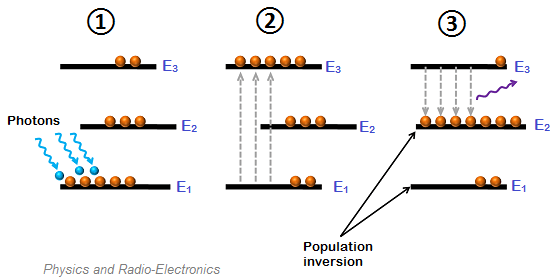
Credit
This shows that metastable state is that excited state in which electrons can stay for longer time as compared with ordinary excited states.Hence electrons can take comparatively longer time to de-excite from metastable to ground state. Also the transition of electron to or from the metastable state is more difficult as compared with other excited states. Hence the direct excitation to metastable state is not easy, to get this excited state the electron is excited to the higher level for spontaneous fall to metastable state. Electrons reach state E2 much faster than they leave state E2. So we can get most of the atoms in excited state E2 than the atoms in state E1 orE3 . This situation is called population inversion.
Laser Action
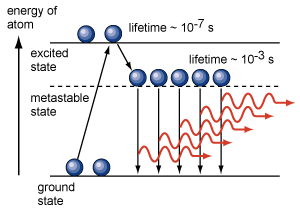
Credit
The atoms in metastable state E2 are bombarded by photons of energy hf =E2-E1 resulting in an induced or stimulated emissions, giving an intense monochromatic beam of light in the direction of incident photon. The emitted photons must be confined in the assembly long enough to stimulate further emission for other excited atoms. This is achieved by using mirrors at the two ends of the assembly. One end is made totally reflecting and the other end is partially transparent to allow the laser beam to escape. As the process continues, photons multiply and resulting radiation is therefore much more intense and coherent than light from ordinary source.
Laser action has been obtained in a large variety of materials including solids, liquid, ionized gases.
Ruby Laser
Ruby is a crystal of Al2O3, a small number if whose Al atoms are replaced by Cr+++ ions. Such ions are Cr atoms that have lost three electrons each. A high intensity helical flash lamp surrounding the ruby provides adequate pumping light to raise the Cr atoms from ground state to the excited state having a short life time of 10-7. The atoms from excited state makes a transition to metastable state with spontaneous emission making the number of atoms larger than those state in excited state, since the life time of electron in metastable state is 10-3. In this process the number of atoms from ground state are going faster to excited state than the number of atoms leaving the metastable state. Population inversion has been created. A few Cr atoms makes transition spontaneously from metastable state to ground state and these emitted photons of wavelength 694.3nm stimulate further transitions. Stimulated emission will dominate stimulated absorption because number of atoms in metastable state is greater than number of atoms in ground state. In this way an intense coherent monochromatic red beam of light.
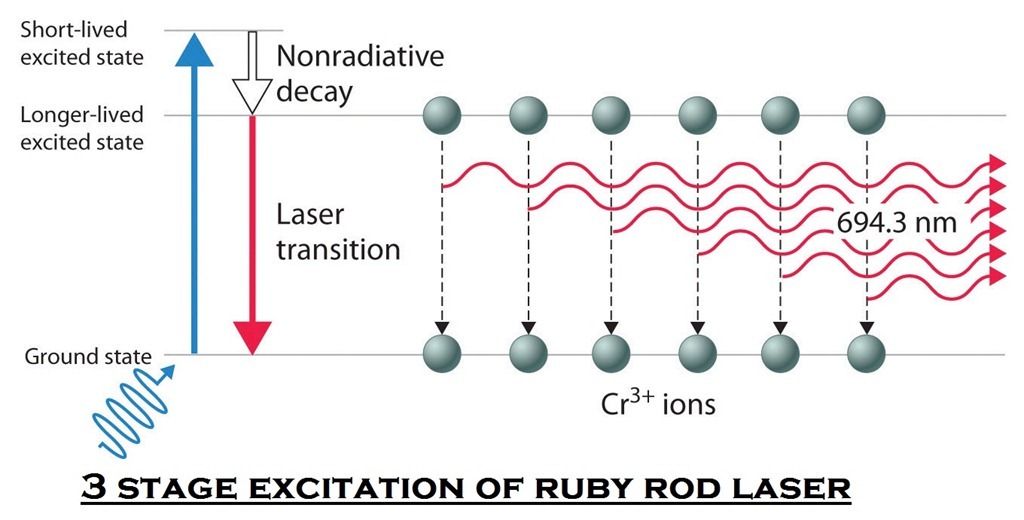
Credit
In practice, the ruby laser is a cylindrical rod with parallel, optically flat reflecting ends, one of which is only partly reflecting. These emitted photons which travel exactly in the direction of the axis are reflected several times, and they are capable of stimulating emission repeatedly. Those photons not in the direction of axis leave through the sides. Thus the number of photons is built up rapidly and leave through partially transparent end of the rod.
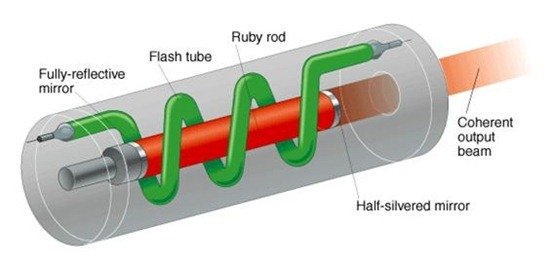
Credit
Helium neon laser:
It is a most common type of laser in physics laboratories. Its discharge tube of the assembly contain 85% helium and 15% neon gas. The neon is lasing or active medium in this tube. Helium and neon have metastable states by chance equal energy values respectively located 20.61 eV and 20.66 eV level.

Credit
The high voltage electric discharge is passed through the tube to excite the electrons in some of the helium atoms to the 20.61 eV state. In this laser, population inversion in neon is achieved by direct collisions with same energy electrons of helium atoms. Thus excited helium atom collide with neon atoms, each transferring its own 20.61 eV of energy to an electron in the neon atom along with 0.05eV of kinetic energy from the moving atoms. As a result, the electrons in neon atoms are raised to the 20.66 eV state.
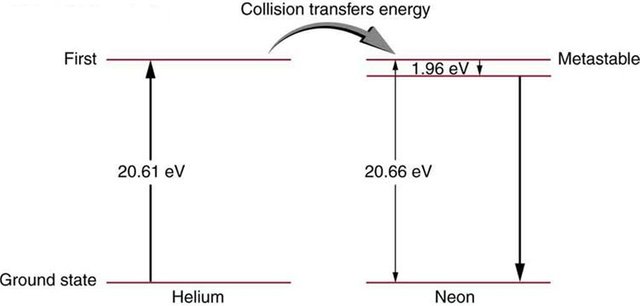
Credit
In the way, population inversion is sustained in the neon gas relative to an energy level of 18.70 eV. The spontaneous emission from neon atoms initiate laser action and stimulated emission causes electrons in the neon to drop from 20.66 eV to 18.70 eV and red laser light of wavelength 632.8 nm corresponding to 1.96 eV energy is generated.The stimulated emission photon that are parallel to the axis of the tube move back and forth through the discharge tube many times by successive reflections from mirrors. These photons can in turn cause other stimulated emissions to occur. A chain reaction thus builds up rapidly in this direction, and the inherent parallelism of the laser light results.
Application of Laser
There are number of applications of laser technology. Some applications are as follows:-
- Three dimensional images of objects obtained by using laser in a process called holography.
- As a surgical tool for welding detached ratina
- To perform precision surveying and lengths measurments.
- As a potential energy source for inducing nuclear fusion reaction.
- For communication along optical fibers.
- For precision cutting of metals and other materials.
These and other applications are possible only because of the unique characteristics of laser.
Reference:-
http://www.physics-and-radio-electronics.com/physics/laser/laser-populationinversion.html
http://www.mechanicalengineeringblog.com/4038-how-laser-beam-welding-works-laser-beam-welding-process/#.WpLtqndRXMI
https://opentextbc.ca/physicstestbook2/chapter/applications-of-atomic-excitations-and-de-excitations/
https://en.m.wikipedia.org/wiki/Helium%E2%80%93neon_laser
Good teknologi
Thanks
Upvoted ☝ Have a great day!
Thanks
Really nice explanations, we have a same field i think.
Perhaps
informative post. i like it.
post is upvoted and following you.
뭔가.. 인돈사님 글은 읽으면 저도 경험하는듯한 기분이 들어요ㅋㅋ
No clue about what you said.